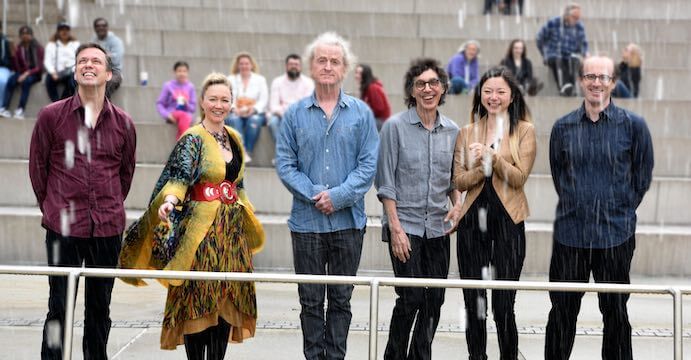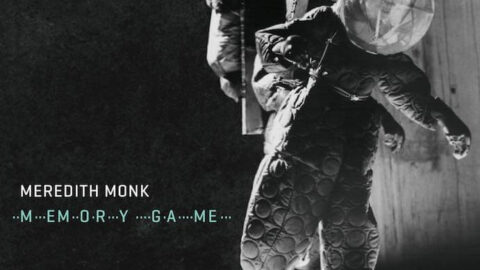Meredith Monk is a composer, musician, and interdisciplinary artist who has been experimenting with the musical capabilities of the human voice since her 1966 work 16mm Earrings (her first vocal score). Almost every citation of Monk’s practice, past and present, describes her as, “a pioneer of extended vocal techniques.” She has always been interested in the voice as an instrument—that is, divorced from text—and more recently, in instruments making music like voices. Combining her own Vocal Ensemble with a group like the Bang on a Can All-Stars for her most recent album, Memory Game (Cantaloupe Music, 2020), seems like a natural collaboration.
The beauty and peculiarity of Memory Game is that it is built entirely from new arrangements of Monk’s music. Arrangements are, effectively, time machines: they begin as a conversation between the composer and the arranger—or between the composer and a previous self. They carry the potential for both affirmation and change in the re-interpretation of the piece. To a composer, an arrangement can mean a circling-back, a chance to try new procedures on a familiar set of materials, or a chance to re-examine ideas a second (or third, or fourth) time. Arrangements aren’t merely a re-figuring of the same pieces into a different structure; they carry with them all of the knowledge and experience from the intervening time between the work now and the work then, from the composer now to the composer then.

The original materials for Memory Game date back to Monk’s 1983 work The Games: A Science Fiction Opera and her albums Turtle Dreams (1983) and Do You Be (1987). For some of the selected works, this is not their first re-imagining at the hands of their creator. Totentanz appeared on Impermanence (2008) for clarinet and keyboard percussion and on Meredith Monk: Piano Songs (2014) for piano. The portions of The Games included on Memory Games overlap with those included on Do You Be, but Monk has chosen different excerpts–“Memory Song” is almost unchanged; the “Panda Chants” are absent.
The album opens with five arrangements from The Games (“Spaceship,” “Gamemaster’s Song,” “Migration,” “Memory Song,” and “Downfall”). “Spaceship” is all-instrumental minimalist chamber music and the only track with no electronic instruments. It has a lushness in Monk’s hands (and in those of arranger Michael Gordon) that minimalism often lacks, but maintains a relentless momentum. The subsequent four movements bring in more sci-fi elements: electronic sounds, Ping Chong’s text for “Migration,” voices speaking a mechanized text of individual words, and Monk’s signature extended vocal techniques. The “Gamemaster’s Song” might be the most classic Monk on the album–I could hear echoes of Dolmen Music and Education of the Girl Child (both 1981) as easily as I could hear Impermanence (2008) and fragments of On Behalf of Nature (2016). Relatively speaking, “Downfall” has the least resolution for its chaos by the end and is the lowest-energy movement of the entire suite, from which the subsequent four dances then climb.
The four dances that follow The Games are all separate, drawn mostly from Do You Be and Turtle Dreams. The Politics of Quiet: Waltz in 5s is much smaller and more intimate, serving as a contrast to the opera excerpts. “Waltz” is a term that Monk interprets liberally—as she does with most dance designations in her repertoire—and the title seems more apt to suggest the intimacy of two people dancing more than a specific rhythmic structure.

Dance in this context offers an alternate reality to the stark future that The Games seems to imagine. Turtle Dreams Cabaret: Tokyo Cha Cha nods to clave rhythms and salsa band horn sections (electronically), though very subtly. Impermanence: Totentanz has seen more than one iteration before this one. “Totentanz” is a dance, but of the four, it is the least defined. The clarinet acts as the solo dancer in this case, the only consistent thread floating above a constantly-changing accompaniment. The final selection, Acts from Under and Above: Double Fiesta, keeps with the rhythmic spirit of the previous three dances and makes an excellent ending to Memory Game. This is more classic Monk–there’s a mix between sung text, sung sounds, spoken text, spoken sounds, and half-sung half-spoken versions in between, all weaving quickly in and out of each other.
From the beginning, Monk has demonstrated that she’s not willing to underestimate her audience. The arrangements that make up Memory Game have an arc of their own, and aren’t only a retrospective or a museum of her previous work; she expects her audience to follow her as they are able, and to trust her artistic vision. I don’t believe that Monk was out to “prove” anything with this album, but with it, she has proven that an artist who is true to their vision cannot exhaust their material.
























